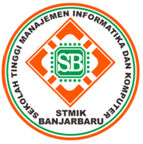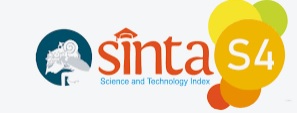Media Pembelajaran Interaktif Pengenalan Jenis - Jenis Ikan Berbasis Augmented Reality
Abstract
Augmented Reality is a virtual object capable of conveying information so that it can assist humans in carrying out their daily work. The teaching and learning process carried out in grade 3, especially for the material on theme 1, sub-theme 3, learning 3 regarding the types of fish and their characteristics, has limitations, and the teacher has difficulty if he has to present various kinds of fish directly. This study aims to apply an interactive learning media for the introduction of fish species based on Augmented Reality at SDN 1 Mataram. The methodology used is the ADDIE method which consists of 5 stages, namely analysis, design, development, implementation, and evaluation. The results achieved are interactive learning media applications for the introduction of types of fish using Augmented Reality which can be run on an Android smartphone. The conclusion of this study is that the application of interactive learning media applications for the introduction of fish species based on Augmented Reality for grade 3 students at SDN 1 Mataram can help students obtain a wider variety of fish and more complete information. The test results are using a Likert scale with a value of 33.46 which is in the Strongly Agree category.
Keywords: Learning Media; Fish Type; Augmented Reality; Androids
Â
Abstrak
Augmented Reality adalah objek virtual yang mampu menyampaikan informasi sehingga dapat membantu manusia dalam melakukan pekerjaannya sehari-hari. Proses belajar mengajar yang dilakukan pada kelas 3 khususya untuk materi tema 1 subtema 3 pembelajaran 3 mengenai jenis-jenis ikan dan cirinya memiliki keterbatasan, serta pengajar mengalami kesulitan jika harus menghadirkan macam-macam ikan secara langsung. Penelitian ini bertujuan untuk menerapkan media pembelajaran interaktif pengenalan jenis-jenis ikan berbasis Augmented Reality pada SDN 1 Mataram. Metodologi yang digunakan yaitu metode ADDIE yang terdiri dari 5 tahapan yaitu analysis, design, development, implementation, dan evaluation. Hasil yang dicapai yaitu aplikasi media pembelajaran interaktif pengenalan jenis-jenis ikan menggunakan Augmented Reality yang dapat dijalankan pada smartphone android. Kesimpulan dari penelitian ini adalah penerapan aplikasi media pembelajaran interaktif pengenalan jenis-jenis ikan berbasis Augmented Reality untuk siswa kelas 3 SDN 1 Mataram dapat membantu siswa memperoleh ragam ikan yang lebih banyak dan informasi yang lebih lengkap. Hasil pengujian dengan mengugunakan skala likert dengan nilai 33.46 yang berada pada kategori Sangat Setuju.
Kata kunci: Media Pembelajaran; Jenis Ikan; Augmented Reality; Android
References
H. Saksono, “Ekonomi Biru: Solusi Pembangunan Daerah Berciri Kepulauan Studi Kasus Kabupaten Kepulauan Anambas,†J. Bina Praja, vol. 05, no. 01, pp. 01–12, 2013, doi: 10.21787/jbp.05.2013.01-12.
S. Vasilis, N. Nikos, and A. Kosmas, “An Augmented Reality Framework for Visualization of Internet of Things Data for Process Supervision in Factory Shop-Floor,†Procedia CIRP, vol. 107, no. March, pp. 1162–1167, 2022, doi: 10.1016/j.procir.2022.05.125.
C. L. Chiu, H. C. Ho, T. Yu, Y. Liu, and Y. Mo, “Exploring information technology success of Augmented Reality Retail Applications in retail food chain,†J. Retail. Consum. Serv., vol. 61, no. March, p. 102561, 2021, doi: 10.1016/j.jretconser.2021.102561.
A. Sucipto, R. H. Kusumodestoni, A. K. Zyen, and M. Husen, “Penerapan Aplikasi Mobile Information Karimun Island Menggunakan Ionic Framework,†JTET (Jurnal Tek. Elektro Ter., vol. 7, no. 1, pp. 1–30, 2018, [Online]. Available: https://jurnal.polines.ac.id/index.php/jtet/article/view/1122%0Ahttp://files/153/Sucipto et al_2018_Penerapan Aplikasi Mobile Information Karimun Island Menggunakan Ionic Framework.pdf%0Ahttp://files/151/1122.html.
K. Rengganis and L. Kusdibyo, “Persepsi Penggunaan Fitur Augmented Reality pada Platform Online Shopping Berbasis Technology Acceptance Model,†Pros. 11th Ind. Res. Work. Natl. Semin., pp. 26–27, 2020, [Online]. Available: https://jurnal.polban.ac.id/proceeding/article/view/2157.
F. Yasin et al., “Pemanfaatan Augmented Reality Untuk Game Edukasi Bagi,†J. SIMETRIS, vol. 8, no. 1, pp. 91–98, 2017.
C. J. McCarthy and R. N. Uppot, “Advances in Virtual and Augmented Reality—Exploring the Role in Health-care Education,†J. Radiol. Nurs., vol. 38, no. 2, pp. 104–105, 2019, doi: 10.1016/j.jradnu.2019.01.008.
N. Norouzi, K. Kim, G. Bruder, J. N. Bailenson, P. Wisniewski, and G. F. Welch, “The advantages of virtual dogs over virtual people: Using augmented reality to provide social support in stressful situations,†Int. J. Hum. Comput. Stud., vol. 165, p. 102838, 2022, doi: 10.1016/j.ijhcs.2022.102838.
S. Gurusubramani, M. Sureshanand, J. Jeganamarnath, D. Sathishkumar, and A. Sheela, “Augmented Reality in Military Applications,†Int. J. Eng. Adv. Technol., vol. 9, no. 1S, pp. 51–54, 2019, doi: 10.35940/ijeat.a1010.1091s19.
Z. He, L. Wu, and X. (Robert) Li, “When art meets tech: The role of augmented reality in enhancing museum experiences and purchase intentions,†Tour. Manag., vol. 68, pp. 127–139, 2018, doi: 10.1016/j.tourman.2018.03.003.
T. L. Huang, “Restorative experiences and online tourists’ willingness to pay a price premium in an augmented reality environment,†J. Retail. Consum. Serv., vol. 58, no. August 2020, p. 102256, 2021, doi: 10.1016/j.jretconser.2020.102256.
N. N. Stone et al., “Remote surgical education using synthetic models combined with an augmented reality headset,†Surg. Open Sci., vol. 10, pp. 27–33, 2022, doi: 10.1016/j.sopen.2022.06.004.
D. Mourtzis, V. Samothrakis, V. Zogopoulos, and E. Vlachou, “Warehouse Design and Operation using Augmented Reality technology: A Papermaking Industry Case Study,†Procedia CIRP, vol. 79, no. March, pp. 574–579, 2019, doi: 10.1016/j.procir.2019.02.097.
R. E. Izzaty, B. Astuti, and N. Cholimah, Practical Augmented Reality. 1967.
M. Y. Suyudi, F. Yanti, and J. Sutresna, “Penerapan Augmented Reality Sebagai Media Pembelajaran Organ Dalam Tubuh Manusia Berbasis Android,†JOAIIA J. …, vol. 2, no. 1, pp. 10–18, 2021.
G. Thadeo, A. Kusuma, I. M. A. Wirawan, and I. K. R. Arthana, “PENGEMBANGAN MEDIA PEMBELAJARAN PENGENALAN JENIS-JENIS IKAN BERBASIS VIRTUAL REALITY Jurnal Nasional Pendidikan Teknik Informatika | 295,†J. Nas. Pendidik. Tek. Inform., vol. 6, pp. 294–304, 2017.
K. Teguh, Martono and A. Fauzi, “Rancang Bangun Media Pembelajaran Pengenalan Spesies Ikan dengan,†Edu Komputika J., vol. 5, no. 1, pp. 44–50, 2018, [Online]. Available: https://journal.unnes.ac.id/sju/index.php/edukom/article/view/23015.
Muhammad Alfiansyah, “Perancangan Augmented Reality Pengenalan Hewan Sebagai Media Pembelajaran Untuk Anak Usia Dini.,†Repos. Univ. Esa Unggul, vol. 6, p. 14, 2018, [Online]. Available: https://digilib.esaunggul.ac.id/public/UEU-Undergraduate-12193-jurnal.Image.Marked.pdf.
Y. Sahria, P. Sudira, and I. Y. Pasa, “Penerapan Teknologi Augmented Reality Untuk Edukasi Hewan Purbakala Dengan Metode Marker Tracking Pada Snapchat,†J. Ilm. Komput., vol. 19, no. 1, pp. 49–60, 2023.
J. Moedjahedy, A. Bokang, and A. Raranta, “Aplikasi Pengenalan Ikan Hias Predator Air Tawar Menggunakan Teknologi Augmented Reality Berbasis Android,†CogITo Smart J., vol. 3, no. 1, pp. 91–99, 2017, doi: 10.31154/cogito.v3i1.48.91-99.
F. Hidayat and M. Nizar, “Model Addie (Analysis, Design, Development, Implementation and Evaluation) Dalam Pembelajaran Pendidikan Agama Islam,†J. Inov. Pendidik. Agama Islam, vol. 1, no. 1, pp. 28–38, 2021, doi: 10.15575/jipai.v1i1.11042.
How To Cite This :
Refbacks
- There are currently no refbacks.










